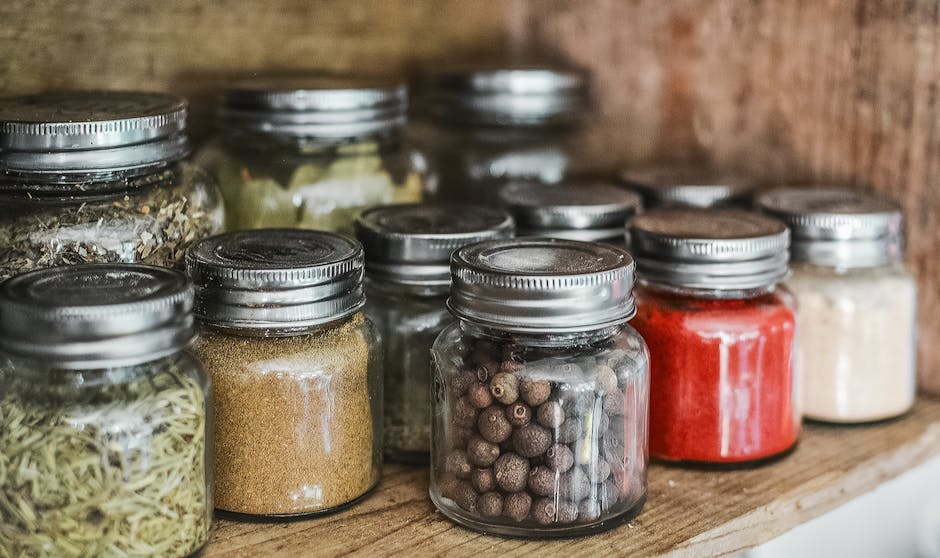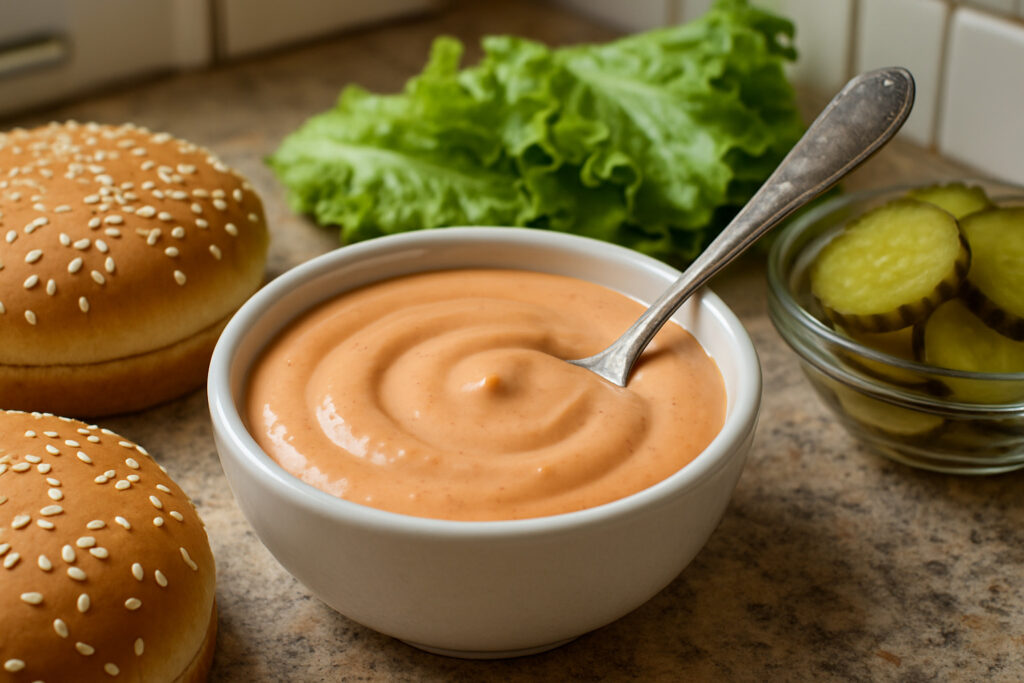The Secret to Iconic Fast Food Flavor at Home
Big mac sauce is a creamy, tangy condiment that gives the McDonald’s Big Mac its signature flavor. If you’re looking for a quick answer on how to make it at home without special ingredients, here’s what you need:
Basic Big Mac Sauce Recipe:
- 3/4 cup mayonnaise
- 2 tablespoons sweet pickle relish
- 1 tablespoon yellow mustard
- 1/2 teaspoon white vinegar
- 1/2 teaspoon paprika
- 1/4 teaspoon garlic powder
- 1/4 teaspoon onion powder
- 1 teaspoon sugar (optional)
Ever had that fast-food craving but didn’t want to leave the house? You’re not alone. Since its introduction in 1968, the big mac sauce has become one of the most beloved condiments in fast-food history, with McDonald’s serving nearly 70 million people daily across 118 countries.
What makes this sauce special isn’t some secret ingredient locked in a vault – it’s actually the perfect balance of creamy, tangy, and slightly sweet flavors that hit all your taste buds at once. While McDonald’s has kept their exact formula under wraps for decades, food enthusiasts and former McDonald’s employees have cracked the code, allowing us to recreate this iconic sauce at home using simple pantry staples.
The beauty of making big mac sauce yourself isn’t just saving a trip to the drive-thru – it’s about customization. You can adjust the sweetness, tanginess, or even make it spicy to suit your preferences. Plus, homemade versions often taste fresher and more vibrant than their fast-food counterparts.
A single batch (about 3/4 cup) can be whipped up in just 5 minutes and will transform not just burgers, but sandwiches, salads, and even fries into something special. The sauce keeps in your refrigerator for up to two weeks, making it a budget-friendly addition to multiple meals.

Big Mac Sauce 101: History, Flavor & Myths
The story of big mac sauce begins in 1967 in a small Pittsburgh kitchen, where McDonald’s franchise owner Jim Delligatti was experimenting with something revolutionary. Delligatti wasn’t just creating another burger—he was crafting what would become a global food icon, and he knew it needed something special to tie everything together.
What many burger fans don’t know is that this famous sauce wasn’t an overnight success. The early big mac sauce went through multiple versions before McDonald’s finally settled on what they internally called “Recipe 72.” This standardization ensured that whether you ordered in Tokyo or Toledo, your Big Mac would deliver that same unmistakable flavor experience.
“Two all-beef patties, Special Sauce, lettuce, cheese, pickles, onions – on a sesame seed bun.” This catchy jingle from 1974 didn’t just sell burgers—it embedded the mysterious “Special Sauce” into America’s cultural consciousness, creating an aura of secrecy that persists to this day.
The sauce’s journey hasn’t been without evolution. In 1991, McDonald’s tweaked the formula slightly, but nostalgia prevailed in 2004 when Fred Turner (a close associate of founder Ray Kroc) championed a return to the original recipe. Turner’s dedication was remarkable—he dug through company archives and even tracked down the original supplier to ensure the authentic big mac sauce would delight a new generation.
Perhaps the most persistent myth about big mac sauce is that it’s simply Thousand Island dressing in disguise. While both share a creamy, pinkish appearance, there’s a fundamental difference: Thousand Island typically contains tomato products like ketchup, while authentic big mac sauce does not. That distinctive pink hue? It comes from paprika, not tomatoes—a small but significant distinction that gives the sauce its unique character.
What makes this sauce so irresistible is its perfect flavor balance. The acidity from white vinegar, sweetness from pickle relish, and savory notes from mustard and spices create what food scientists call a complete “flavor profile”—essentially hitting all your taste buds at once. This isn’t just delicious; it’s scientifically designed to be satisfying.
The numbers behind this sauce tell an incredible story of culinary influence. The Big Mac has been sold in over 100 countries, with big mac sauce being the constant thread connecting these global experiences. When McDonald’s occasionally releases the sauce as a limited retail product, it typically sells out within hours—a testament to the powerful food nostalgia it evokes.

While McDonald’s remains the originator, other fast-food giants have launched their own contenders: Burger King with its Big King sauce, Wendy’s with Dave’s Sauce, Five Guys with its mayo-ketchup blend, Shake Shack’s ShackSauce, In-N-Out’s beloved “spread,” and even broader players like KFC, Carl’s Jr., and Subway experimenting with proprietary burger spreads. All these competing companies highlight just how influential the original big mac sauce has become.
The big mac sauce isn’t just a condiment—it’s a time machine. One taste can transport you back to childhood celebrations, road trips, or late-night drives with friends. This powerful nostalgia factor explains why, more than five decades after its creation, people are still trying to recreate this magical sauce in their own kitchens.
Ingredient Breakdown & Easy Substitutions
Let’s peek inside the big mac sauce magic and see how you can create this iconic flavor with items probably already hiding in your kitchen:
Mayonnaise (Base): This creamy foundation gives the sauce its luxurious texture. Reach for a quality full-fat mayo like Hellmann’s or Duke’s for the best results – trust me, this isn’t the place to cut corners! The richness of good mayo makes all the difference in your final sauce.
- Substitution: Following a plant-based diet? No problem! Brands like Just Mayo or Vegenaise work beautifully, giving you that same silky texture without any animal products.
That sweet-tangy balance that makes big mac sauce so addictive comes from sweet pickle relish. Those tiny cucumber pieces add both flavor and that subtle textural interest that keeps things interesting bite after bite.
If your pantry only has dill relish, don’t run to the store just yet! Simply add 1-2 teaspoons of sugar to balance the tartness. In a real pinch, finely chopping some sweet pickles works too – the sauce is forgiving that way.
The classic yellow mustard (not fancy Dijon or spicy brown) brings that familiar tang we all know and love. It’s that bright, nostalgic flavor that takes us right back to childhood fast food trips. If Dijon is all you have, use about half the amount since its flavor is more pronounced.
A splash of white vinegar brightens everything up and helps all the flavors become friends. Apple cider vinegar makes a decent stand-in, though it will introduce a slight fruity note. White wine vinegar works beautifully too if you happen to have that on hand.
That signature pinkish-orange color? That comes from paprika, which also adds a subtle warmth. Many home cooks actually prefer using smoked paprika for an extra dimension of flavor. For those who want the color without any heat, a tiny pinch of turmeric does the trick.
Garlic powder and onion powder provide that savory depth without interrupting the sauce’s smooth texture. If you’re out of either, you can substitute very finely minced fresh garlic (just 1/8 teaspoon) or onion (1 teaspoon), though this will change the texture slightly.
A touch of sugar balances everything perfectly, though it’s technically optional. Honey or maple syrup can offer interesting flavor variations, while keto followers might prefer monk fruit sweetener or erythritol for that sweet balance without the carbs.
While some recipes include French dressing or ketchup, these aren’t authentic to the original. That said, a few drops of BBQ sauce can be a fun twist if you’re feeling adventurous with your homemade version!
For those with dietary needs, big mac sauce is surprisingly adaptable:
- Keto friends: Use sugar-free sweet pickle relish and skip the added sugar
- Gluten-sensitive: Most ingredients are naturally gluten-free, but always double-check your mayo and relish labels
- Allergy-conscious: Those with egg allergies can use egg-free mayo alternatives
According to McDonald’s nutrition information, a serving of big mac sauce contains about 70 calories. Our homemade version typically lands around 60-70 calories per tablespoon, depending on your specific ingredient choices.
The beauty of making this sauce at home isn’t just saving a trip through the drive-thru – it’s being able to adjust every element to your personal taste. A little more tang? A touch more sweetness? The power is deliciously in your hands!
DIY Big Mac Sauce: Step-by-Step Guide
Making your own big mac sauce at home is surprisingly simple and requires no cooking. Here’s our foolproof method:
The beauty of homemade big mac sauce lies in its simplicity. Start by gathering all your ingredients before mixing—this ensures you won’t be scrambling for paprika with mayo-covered hands! Add your mayonnaise to a medium bowl, then introduce each supporting player: the sweet pickle relish, yellow mustard, white vinegar, paprika, garlic powder, onion powder, and optional sugar.
Grab a whisk (or even a fork will do) and blend everything together until smooth and uniform. Don’t rush this step—take your time to break up any spice clumps for that perfectly smooth texture. This is your moment to play sauce chef! Too tangy? Add a pinch more sugar. Not enough zing? A few extra drops of vinegar will do the trick.
Once you’re happy with your creation, transfer it to an airtight container and let it chill in the refrigerator. While you could use it right away, magic happens during those hours of rest. The flavors need time to get acquainted—like guests at a dinner party who become best friends by dessert. Two hours will do in a pinch, but overnight chilling yields the most authentic flavor.
| Comparison | Homemade Big Mac Sauce | McDonald’s Big Mac Sauce |
|---|---|---|
| Calories (2 tbsp) | ~60-70 calories | 70 calories |
| Cost per batch | ~$1.50 | N/A (only on burgers) |
| Shelf life | Up to 2 weeks refrigerated | Contains preservatives for extended shelf life |
| Customizable | Yes – adjust to taste | No |
| Prep time | 5 minutes + chill time | None (pre-made) |
Big Mac Sauce in 5 Minutes
When burger cravings strike without warning, this quick version of big mac sauce has your back:
Start with ice-cold mayonnaise straight from the fridge—this gives you a head start on the chilling process. Mix in your remaining ingredients with vigor until perfectly smooth. Then employ a little kitchen hack: pop the bowl in the freezer for exactly 10 minutes (set that timer—forgotten sauce is sad sauce!). Give it one final stir before dolloping onto your burgers.
This speedy version makes about 3/4 cup of sauce—enough to generously dress 8-12 burgers, depending on how saucy you like them. While it won’t have quite the same depth as the overnight version, it’ll still deliver that signature flavor when you need it most.
Layering Your Homemade Big Mac with Big Mac Sauce
Creating an authentic Big Mac experience is all about architecture. Start by lightly buttering and toasting all three bun pieces—yes, three! That middle piece (the “club”) is essential to the Big Mac experience.
Apply a tablespoon of your freshly made big mac sauce to both the bottom bun and the middle bun piece. On the sauce-laden bottom bun, sprinkle finely chopped onions, add shredded lettuce, and lay down a slice of American cheese. Crown this layer with your first beef patty.
Next comes the middle bun section, already blessed with sauce. Add another layer of shredded lettuce, two or three pickle slices, and your second beef patty. Finally, complete your masterpiece with the top bun.
For truly authentic results, make your beef patties thin (about 1/8 pound each) and slightly wider than your bun—they’ll shrink while cooking. Season them simply with salt and pepper just before they hit the pan. An 80/20 lean-to-fat ratio gives the juiciest results, and a quick cook (just 1-2 minutes per side) in a hot skillet delivers that perfect fast-food texture: thin, with a nice outer crust but still juicy inside.
The first bite of your homemade creation, with that perfect balance of big mac sauce, beef, cheese, and veggies, might just convince you that the best fast food comes from your own kitchen.
Storage, Serving Ideas & Healthy Twists
So you’ve whipped up a delicious batch of big mac sauce – now what? Let’s talk about keeping it fresh and all the wonderful ways to use it beyond just burgers.
Your homemade sauce will stay perfectly delicious for up to two weeks when stored in an airtight container in the refrigerator. I recommend using a glass jar with a tight-fitting lid – it not only keeps things fresh but also makes it easy to see how much sauce you have left. Always use a clean spoon when dipping into your sauce jar to prevent any unwanted bacteria from crashing your sauce party.
One important note: unlike many condiments, big mac sauce doesn’t freeze well. The mayonnaise base tends to separate when thawed, leaving you with an unappetizing, broken sauce. Trust me, I’ve tried it so you don’t have to!
Your sauce creation is incredibly versatile – it’s practically begging to upgrade more than just burgers. Spread it on your everyday turkey sandwich to transform your lunch from boring to crave-worthy. I love using it as a dip for crispy french fries or sweet potato wedges – the tangy-sweet flavor complements the salty potatoes perfectly.
For lighter fare, try thinning the big mac sauce with a splash of milk or water to create a creamy salad dressing that will make even simple greens taste indulgent. It’s particularly delicious on a deconstructed burger bowl if you’re cutting back on carbs but still craving those Big Mac flavors.

Watching your calories or accommodating dietary restrictions? No problem! Big mac sauce is surprisingly adaptable to healthier tweaks:
For a lighter version with a protein boost, replace half the mayonnaise with Greek yogurt. You’ll get a tangier sauce with fewer calories and more protein. Following a plant-based diet? Simply swap in your favorite vegan mayo – the other ingredients are typically already vegan-friendly.
If you’re cutting back on sugar, use dill relish instead of sweet and skip the added sugar altogether. The sauce will have a slightly different flavor profile but still maintains that special something that makes it recognizable.
Heat lovers can add a metabolism-boosting kick with a few dashes of hot sauce or a pinch of cayenne pepper. The spice plays beautifully with the creamy, tangy base. For a fresh twist, try folding in some finely chopped fresh herbs like dill or parsley.
When you break it down, a full batch of homemade big mac sauce contains roughly 800-900 total calories, with each tablespoon providing about 60-70 calories. Considering how many meals a single batch can improve, it’s a caloric bargain that adds tremendous flavor value to your weekly meal prep.
Speaking of meal prep – making a double batch on Sunday can set you up for a week of varied, flavorful meals without extra daily effort. A dollop here and there transforms ordinary dishes into something special, whether it’s jazzing up a wrap, adding zing to deviled eggs, or giving potato salad an unexpected twist.
While we’re focusing on McDonald’s Big Mac sauce, it’s worth noting that other major chains like Five Guys, Shake Shack, and In-N-Out all have their own signature sauces that inspire similar devotion. Each has a unique flavor profile, with In-N-Out’s “spread” being perhaps the closest competitor to the classic big mac sauce experience.
More info about The Secret Behind Our Signature Sauces & Seasonings
Frequently Asked Questions about Big Mac Sauce
What makes Big Mac sauce different from Thousand Island?
Ever noticed how people often say big mac sauce is just Thousand Island dressing? They’re not entirely wrong – both have that creamy pinkish appearance – but the differences are what make McDonald’s sauce truly special.
For starters, authentic big mac sauce contains no ketchup or tomato products whatsoever. That signature color? It comes from paprika, not tomatoes. Thousand Island, on the other hand, gets its hue and tanginess from ketchup or tomato paste.
The sweet pickle relish in big mac sauce provides those little bits of texture and sweetness that make each bite interesting. The specific blend of paprika, garlic powder, and onion powder creates that unmistakable flavor you can’t quite place but definitely recognize.
A former McDonald’s manager once confirmed what many suspected – the sauce was never intended to be Thousand Island dressing. It was specifically crafted to complement the other Big Mac components, creating that perfect harmony of flavors that keeps people coming back decade after decade.
When you make it at home, you’ll notice the consistency too – big mac sauce is typically thicker and less runny than store-bought Thousand Island, helping it stay put on your burger rather than dripping all over your hands.
Can I use dill relish instead of sweet?
Found yourself with only dill relish in the fridge when you’re craving homemade big mac sauce? Don’t worry – you can absolutely make the swap, with a few simple adjustments.
If you’re using dill relish, you’ll want to add about 1-2 teaspoons of sugar to make up for the missing sweetness. Dill relish naturally brings a more pronounced pickle flavor and less sweetness to the party, which some people actually prefer! The original McDonald’s recipe does use sweet pickle relish, but that doesn’t mean your version can’t be even better.
I’ve had friends who dislike overly sweet condiments who absolutely love the big mac sauce made with dill relish. It creates a slightly different flavor profile that’s a bit more complex and adult.
My recommendation? Make a small test batch first before committing to a full recipe. Just mix a tablespoon of mayo with proportionally smaller amounts of the other ingredients using dill relish and see if you enjoy the flavor. You might find your new favorite sauce variation!
How can I fix a sauce that tastes too sweet or too sour?
Even experienced cooks sometimes need to make adjustments. If your big mac sauce isn’t hitting quite right, here’s how to bring it back into balance:
When your sauce is too sweet, try adding more yellow mustard (just 1/4 teaspoon at a time) or a few drops of white vinegar to cut through the sweetness. A tiny pinch of salt can also help balance things out, as can a drop or two of fresh lemon juice.
If your big mac sauce turned out too sour or tangy, don’t panic! Add a pinch more sugar or a small drizzle of honey to balance the acidity. You can also mix in a bit more mayonnaise to dilute the sourness. For extreme cases, a very small pinch of baking soda can neutralize excess acidity – but be careful, a little goes a long way!
Sometimes the issue isn’t sweetness or sourness but blandness. Check if your paprika is fresh – spices lose potency over time, and that might be why your sauce lacks punch. Add a pinch more garlic and onion powder, ensure you’ve used enough salt, and remember that big mac sauce actually tastes better after resting in the refrigerator for a few hours as the flavors develop and meld together.
The golden rule when fixing any sauce: make adjustments gradually and taste after each addition. You can always add more of something, but it’s nearly impossible to take it away once it’s in there!

Conclusion
Creating your own big mac sauce at home isn’t just about saving a few dollars—it’s about starting on a little food trip right in your own kitchen. There’s something deeply satisfying about recreating that familiar, crave-worthy flavor while having complete control over every ingredient that goes into it.
I’ve found that homemade big mac sauce is truly the gift that keeps on giving. One 5-minute batch on Sunday can transform an entire week of meals. That burger on Monday, the turkey sandwich at Tuesday’s lunch, Wednesday’s salad that needed a little something extra—they all become more exciting with a dollop of this creamy, tangy goodness.
What makes this sauce so special isn’t just its flavor—it’s the memories it evokes. For many of us, that first bite of a sauce-slathered burger brings back road trips, celebrations, or late-night drives with friends. When you recreate it at home, you’re not just making a condiment; you’re capturing a little bit of that nostalgia in a jar.
The beauty of mastering big mac sauce is that it empowers you as a home chef. Once you understand how these flavors work together, you can start experimenting with your own signature variations. A little more heat here, a bit less sweetness there—soon you’ll have friends and family asking for “your” special sauce.
While McDonald’s has the original, other major burger chains like Burger King, Wendy’s, and Carl’s Jr. have developed their own signature sauces trying to capture that same magic. Each has its devoted fans, but there’s something about the original big mac sauce that continues to set the standard for burger condiments worldwide.
At The Dining Destination, we believe that understanding iconic flavors from around the world enriches your culinary experiences, whether you’re traveling abroad or simply gathering around your dining table. Food is a universal language, and learning to speak it fluently—even just one sauce at a time—connects us to culinary traditions everywhere.
Next time you’re craving that familiar fast-food flavor, skip the drive-thru and reach for your mixing bowl instead. Your wallet, taste buds, and anyone lucky enough to share your table will thank you.
For more culinary trips and insider tips on recreating famous dishes from around the world, explore our other guides and recipes. Whether you’re planning your next food-focused vacation or looking to expand your repertoire of homemade classics, we’re here to guide you through all the delicious possibilities.
More info about our restaurant guides
Have you tried making your own big mac sauce yet? We’d love to hear how it turned out and what creative ways you’ve found to use it beyond the classic burger. The best culinary journeys are the ones we share!








